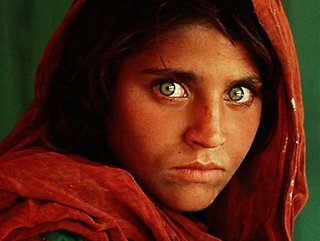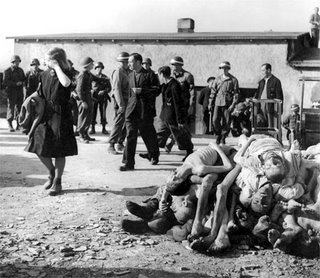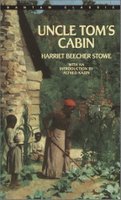Wednesday, August 30, 2006
Photographs that Shook the World

The photograph above, by Steve McCurry, can easily be recognised as it was much hyped by National Geographic Channel. The haunting green eyes of the girl haunted the whole world since the time it appeared on National Geographic Magazine cover in 1985. It is the first picture that come to our minds when talking about refugees. Torn apart by civil war, the plight of refugees was brought forward to the rest of the world through this very photograph. More info. here

The Pulitzer prize winning photograph above was taken by South African photographer Kevin Carter. The shocking picture of a sever year old girl 'resting' for a while before going to the refugee shelter for food being stalked by a plump vulture brought attention to the gravity of Sudan's famine in 1993-94. The photographer managed to shoo the vulture away, but no one knows what happened to this little girl. Burdened by the sight of so many sufferings in Africa, the photographer committed suicide 3 months after the photograph was shot. In his note, he says "I am depressed ... without phone ... money for rent ... money for child support ... money for debts ... money!!! ... I am haunted by the vivid memories of killings & corpses & anger & pain ... of starving or wounded children, of trigger-happy madmen, often police, of killer executioners...I have gone to join Ken if I am that lucky." More info. here

This pic. is in the forefront of all anti-war campaigns. This was June 1972 when a South Vietnamese plane "mistakenly" dropped its flaming napalm on South Vietnamese This girl was also found and she is fine with image being used to discourage war. Unfortunately no one's listening.

South Vietnamese National Police Chief Brig. Gen. Nguyen Ngoc Loan executes a Viet Cong officer with a shot to the head, one of the most chilling images of the Vietnam War. Photographer Eddie Adams, who won a Pulitzer Prize for this photograph, said the execution was justified, because the Viet Cong officer had killed eight South Vietnamese. The furor created by this 1968 image destroyed Loan's life. He fled South Vietnam in 1975, the year the communists overran the country, and moved to Virginia, where he opened a restaurant. He died in 1998 at age 67. Loan 'was a hero,' Adams said when he died. 'America should be crying. I just hate to see him go this way, without people knowing anything about him.' (Source)

When LIFE ran this stark, haunting photograph of a beach in Papua New Guinea on September 20, 1943, the magazine felt compelled to ask in an adjacent full-page editorial, “Why print this picture, anyway, of three American boys dead upon an alien shore?” Among the reasons: “words are never enough . . . words do not exist to make us see, or know, or feel what it is like, what actually happens.” But there was more to it than that; LIFE was actually publishing in concert with government wishes. President Franklin D. Roosevelt was convinced that Americans had grown too complacent about the war, so he lifted the ban on images depicting U.S. casualties. Strock’s picture and others that followed in LIFE and elsewhere had the desired effect. The public, shocked by combat’s grim realities, was instilled with yet greater resolve to win the war. (Source)

LIFE photographer Margaret Bourke-White was with Gen. George Patton's troops when they liberated the Buchenwald concentration camp. Forty-three thousand people had been murdered there. Patton was so outraged he ordered his men to march German civilians through the camp so they could see with their own eyes what their nation had wrought. (Source)

Finally a glimmer of hope. This is Tiananmen Square 1989. A hunger strike by 3,000 students in Beijing had grown to a protest of more than a million as the injustices of a nation cried for reform. For seven weeks the people and the People’s Republic, in the person of soldiers dispatched by a riven Communist Party, warily eyed each other as the world waited. When this young man simply would not move, standing with his meager bags before a line of tanks, a hero was born. A second hero emerged as the tank driver refused to crush the man, and instead drove his killing machine around him. Soon this dream would end, and blood would fill Tiananmen. But this picture had shown a billion Chinese that there is hope. That's the power of ONE. (Source)
I really don't know what effect Live8 concert had on African Debts. But I do know that the cries of Darfur is falling on deaf ears because of lack of oil in that region. UNO has declined to call it a genocide. Perhaps we dont know how many deaths will take till they know that too many people have died. I hope it will not take a disturbing photograph like above to divert the world's attention to Darfur.
Friday, August 18, 2006
Uncle Tom's Cabin: A Review

Author: Harriet Beecher Stowe
Rating: 5+ Stars
Publishers: Wordsworth Classic Series
Cost: Rs. 100
Undoubtedly, Uncle Tom’s Cabin (UTC), by Harriet Beecher Stowe, is the best book I have read so far. This book deals with slavery as its central theme. Wiki tells me that UTC is the second most selling book of the nineteenth century after the Holy Bible (and deservingly so). The book can keep you engrossed for a long time. I have tried to minimize the spoilers in this review. I can assure you that no matter how many spoilers any post can reveal, it simply can’t ruin the fun of reading the book by yourself.
The story presents itself in the house of gracious host to enslaved African Americans. Arthur Shelby, a kind hearted gentleman, is the ‘owner’ of several slaves including the protagonist Tom. Being under terrible debt, Shelby decides to do away with some of his slaves. The first chapter, ‘in which the reader is introduced to humility’, is one of the most powerful pieces of writing on human values. The fact that being a ‘Christian’ means possessing sublime virtues which often lack in common people is well reflected. Tom is described as a true Christian for his sheer diligence, dedication to work and for his humility. He is respected by his ‘owner’ to a great extent. Reading first few pages leave you feeling bitter about the fact that Blacks were looked upon as mere objects that could perform work mechanically and that a few of them who had innate qualities were looked upon as ‘features’ that made them sell for a better price.
The language in the book is highly complicated because of the relatively longer sentences used. The innocuous looking 300-350 page book cannot be finished in a hurry. The archaic language also holds the book to high standards of English writing. The language demands reverence. With some effort, if one is able to get through first three chapters where Black pronunciations, like ‘tis’ for ‘this’, ‘tat’ for ‘that’, are extensively used, the readers can look forward to an amazing experience.
In an effort to pull himself together economically, despite great opposition from Mrs. Shelby, who is as warm hearted, Arthur decides to part himself from Tom. Around the same time, George decides to flee to Canada so as to escape from the hand of a new owner who is not at all likely to be as noble as Arthur Shelby promising his wife Eliza (and their baby boy, Harry) to take her back once he finds freedom.
The story progresses of these two fronts. The story of Tom’s fate of being transferred from place to place subdues the other front of the family’s quest for much sought after independence in Canada. The family’s struggle against their trader’s relentless effort to capture them is plotted extremely well. The trickery, deception and self-centered nature of the trader have been stereotyped, but the build-up is enticing nevertheless. Tom, meanwhile, is passed on from trader to trader, until bought by another Shelby-like host Augustine St. Clare.
The author hasn’t left any stoned unturned when it comes to introducing characters in the novel. Every character has at least a paragraph dedicated to exploring his past to boast about. All relevant aspects of their lives are brought forward by the author. This has paved way for more insightful observations in the novel for common reader like you and me.
The book also illustrates how callous the slave traders have grown owing to the fact that the New England’s society expected them to be so. Incidents of death of a slave or any other major loss to them would not touch the cold-hearted traders emotionally. The description of how carelessly the mothers are separated from son and daughters, husband from wives, brothers from sisters, etc is rich with emotion. Again, the past of the slaves involved has been looked into with a great detail.
Tom lives a relatively easy life for a slave under Augustine. The novel is blessed by the presence of Angelic little girl, Augustine’s Daughter, Eva (Evangeline St. Clare). It was because of her persistent begging to her dad that Tom was bought by him. Eva manages to bond with every one in her house including the slaves insisting on the fact that all of them deserve to be loved. Her mere presence captures the attention of the readers. Augustine’s cousin, Ophelia, who is prejudiced against black, is bought a slave girl named Topsy by Augustine just to show the blacks also have emotions holding them together. Six year old Eva teaches a lesson or two to all in her family about treating slaves a people who need to be understood and loved. Everyone, including her father, is moved by her cherubic nature.
The book is also a grim reminder of the fact that religion is contorted to every possible extent in order to suit the selfish motives. A priest justifies slavery by quoting from bible that things are meant to be the way they are. Africans are meant to be slaves, Whites are meant to rule over them. And that is the word of the lord. After a couple of confrontations between Augustine and his cousin Ophelia, Augustine gave a huge and immensely powerful monologue on Christianity being misrepresented, manipulated by masses and appalling disregard to human values by the so called priests. In my opinion, the monologue was a little too long.
Contrary to expectation that a slave warehouse filthy, crowded little place for slaves to stay temporarily before being sold, the writer has described the place to very luxurious. The intention was, however, to make slaves cheerful so that they can be sold at a higher price. Of course, slaves were given no choice but to indulge themselves in parties and celebration that happen despite their vehement refusal. The author has made painstaking effort to bring out the real truth and motives behind every action taken during slave trade.
By bizarre twist of fate, Tom is sold to merciless plantation owner Simon Legree before spending many days in a slave warehouse. Legree despises the very fact that Tom reads Bible and has a firm faith in Christianity. He is ill-treated in the plantation for helping fellow slaves, and also for not renouncing Christianity. He helps Cassy and Emmeline, two sex slaves owned by Legree. This causes Tom to be further looked down upon by his owner. The book ends on semi-happy and semi-tragic note with some reunions and some sorrow (which I don’t want to reveal).
All in all, it’s a great book. I am compelled to give 5+ stars for it. At Rs. 100 – Rs 130 under different “classic editions”, this book comes dirt-cheap. It’s worth a lot more. And also, I would like to thank Venkat (aka Tak) for suggesting the book in the first place. The e-book is also available here.
Friday, August 04, 2006
Indian Summer Ads
Over this summer, I had access to what we usually don’t, television. Being kept away from television, I hadn’t seen ads for a year. This post is a sequel to a post of mine about a year ago. This year, I was surprised that Pepsi and Coke did not come up with ads lashing out at each other as fervently as they did years before. Also, the quality of ads were not as good as they used to be. I can only name a handful of ads which are worth a mention.
Monster
HSBC’s ‘world local bank’ ad and the slogan ‘understanding your needs better’ is yet another example on how abstract advertising is a great idea. A simple issue like torn jeans being stylish for the daughter and a completely opposite view of the mother brings about the idea that the bank changes according to your need. Earlier this summer, HSBC floated another ad (animated) with months of years making up a car or a house. Though it would have made a great idea for a hoarding, it was ordinary on television.
Sania Mirza’s question-answer session turned out to be one of those ‘good-to-watch-ones-irritating-the-next-time’ ads. The worst in the bag of soft drink ads was Aamir Khan’s ‘thanda samosa’ ad. It is unlike soft drink manufacturers not to come up with good ads especially during summer.
Running up to the foot ball world cup, several ads were featured on football. Adidas ad on two young boys choosing their teams has a touch of brilliance. Also in the context is a well done ad by Maruti Swift, the one with the car playing around with the foot ball. There was one more ad by adidas or nike in which a foot ball is passed around in two lifts until a trophy is captured using the ball. That was choreographed extremely well.
Again, the ads by soaps, shampoos and detergents haven’t explored outside their domain. There are as boring as they can get. It can only take a genius to come up with ‘nihar mein hai kudrat ki sakhi’ for a coconut oil product. We will have to wait and watch before any other product comes up with ideas like that. Till my next vacations, no more television ads on this blog.
Subscribe to Posts [Atom]
